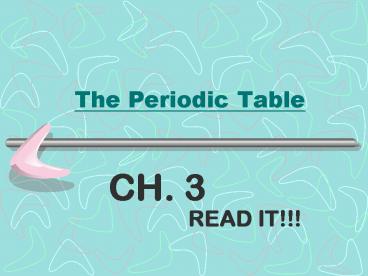The Periodic Table PowerPoint PPT Presentation
1 / 24
Title: The Periodic Table
1
The Periodic Table
CH. 3
- READ IT!!!
2
pp. 62-63
3
Why is the Periodic Table important to me?
- The periodic table is the most useful tool to a
chemist. - It organizes lots of information about all the
known elements. - You get to use it on every test.
4
Pre-Periodic Table Chemistry
The Problem
- was a mess!!!
- No organization of elements.
- Difficult to find information.
- Chemistry didnt make sense.
- Imagine going to a grocery store with no
organization!!
5
Dmitri Mendeleev Father of the Periodic Table
- PROBLEMS
- Set up table by 2 factors increasing atomic
mass and reactivity. - He left blank spaces for what he said were
undiscovered elements. (Turned out he was right!)
- HOW HIS WORKED
- Put elements in rows by increasing atomic mass.
- Put elements in columns by the way they reacted.
6
The Current Periodic Table
- Mendeleev wasnt too far off.
- Moseley set up the current table
- Now the elements are put in rows by
increasing ATOMIC NUMBER!!
7
GroupsHeres Where the Periodic Table Gets
Useful!!
- Elements in the same group have similar chemical
and physical properties!!
- Why??
- They have the same number of valence electrons.
- They will form the same kinds of ions.
8
Families on the Periodic Table(Groups/Families -
same!)
- Columns are also called families.
- Families may be one column, or several columns
put together. - Families have names rather than numbers. (Just
like your family has a common last name.)
9
(No Transcript)
10
(No Transcript)
11
(No Transcript)
12
Hydrogen - 1 valence electron
- Hydrogen belongs to a family of its own.
- Hydrogen is a diatomic, reactive gas.
- Hydrogen was involved in the explosion of the
Hindenburg. - Hydrogen is promising as an alternative fuel
source for automobiles.
13
Alkali Metals1 valence electron
- 1st column on the periodic table (Group 1) not
including hydrogen. - Very reactive metals, always combined with
something else in nature (like in salt). - Soft enough to cut with a butter knife
14
Alkaline Earth Metals 2 valence electrons
- Second column on the periodic table. (Group 2)
- Reactive metals that are always combined with
nonmetals in nature. - Several of these elements are important mineral
nutrients (such as Mg and Ca
15
Transition Metals of valence electrons varies
- Elements in groups 3-12
- Less reactive harder metals
- Includes metals used in jewelry and construction.
- Metals used as metal.
16
Boron Family 3 valence electrons
- Elements in group 13
- Aluminum metal was once rare and expensive, not a
disposable metal.
17
Carbon Family 4 valence electrons
- Elements in group 14
- Contains elements important to life
- Carbon is the basis for an entire branch of
chemistry. - Silicon and Germanium are important
semiconductors.
18
Nitrogen Family5 valence electrons
- Elements in group 15
- Nitrogen makes up over ¾ of the atmosphere.
- Nitrogen and phosphorus are both important in
living things. - Most of the worlds nitrogen is not available to
living things. - The red stuff on the tip of matches is phosphorus.
19
Oxygen Family6 valence electrons
- Elements in group 16
- Oxygen is necessary for respiration.
- Many things that smell bad contain sulfur (rotten
eggs, garlic, skunks, etc.)
20
Halogens7 valence electrons
- Elements in group 17
- Very reactive, volatile, diatomic, nonmetals
- Combine with sodium to form salts. (NaCl)
- Used as disinfectants and to strengthen teeth.
21
The Noble Gases
22
The Noble Gasesfull outer level of valence
electrons
- Elements in group 18
- VERY unreactive, monatomic gases.
- Used in lighted neon signs
- Used in blimps to fix the Hindenburg problem.
- Have a full valence shell.
23
STOP HERE!!!!!!!!!!!!!!
- READ CHAPTER 3!!!
24
The horizontal rows are called periods and are
labeled from 1 to 7. The vertical columns are
called groups are labeled from 1 to 18.

